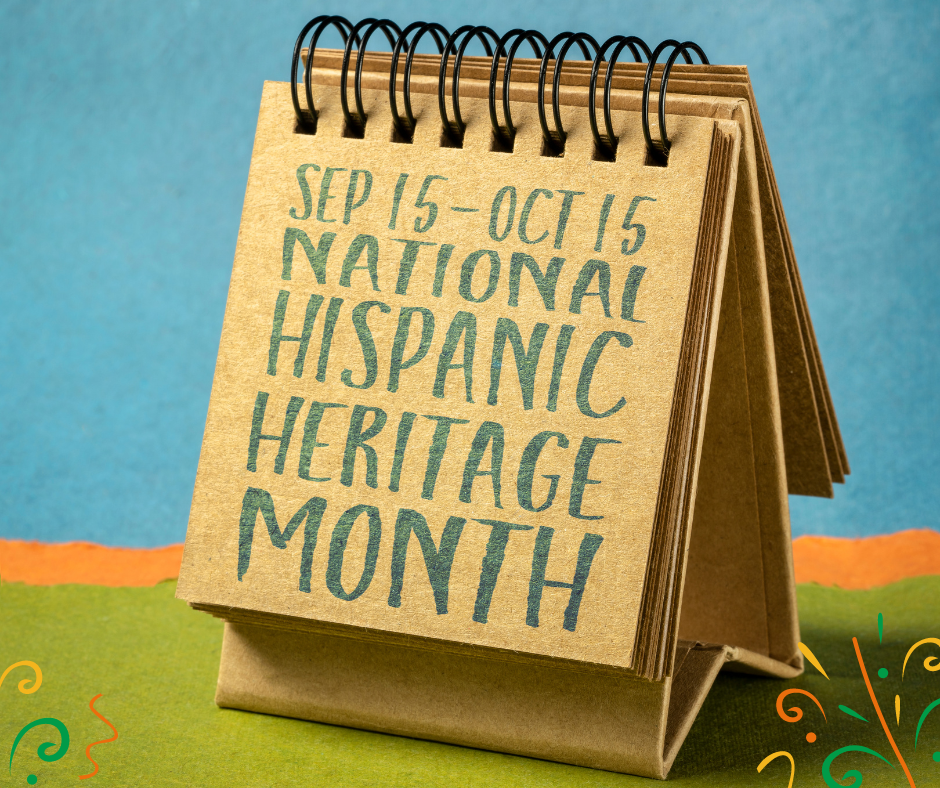Seven Myths and Facts, Plus 37 Resources for Hispanic Heritage Month

Hispanic heritage is foundational to our country. For instance, Spanish was the first European language widely spoken in the country—decades before English became widespread.
For more than 50 years, Americans have acknowledged this foundation through National Hispanic Heritage Month, a 30-day celebration of contributions made by achievers of Caribbean, Central American, Mexican, South American, and Spanish heritage.
The September 15 start date marks the independence anniversaries of Honduras, El Salvador, Nicaragua, Costa Rica and Guatemala. Days later, Mexico and Chile gained their independence. Hence, the significance of the mid-September launch to the month-long celebration.
This year's theme is "Pioneers of Change: Shaping the Future Together," which is a reminder that our beloved country benefits greatly from the contributions made by visionaries of Hispanic and Latin American descent; whose insights, culture and values propel America forward economically, politically, and socially.
To uplift our Hispanic communities and educators who support them, we’ve collected these informational facts and resources for students of all backgrounds.
Hispanic Heritage Month Myths and Facts
Myths and stereotypes hurt any group or individuals, and education is the best way to fight these stereotypes. The below seven myths are ideas and opinions Hispanic individuals regularly encounter, even though they are false.
Read through to see the myths and get the truth.
Myth: Use the term "Latinx" to be inclusive
FACT
A few years ago, the term “Latinx” emerged as a gender-neutral way to refer to those with Hispanic heritage. The goodhearted intent was there but unfortunately, the individuals affected were not consulted.
“Many Latinos like myself see the ‘X’ as odd and off-putting because it doesn’t follow the traditional structure of Spanish, making it awkward and difficult to pronounce because in Spanish few words end with two consonants,” wrote Luisita Lopez Torregrosa for NBC News.
In 2022, a Gallup poll found only four percent of Hispanic Americans preferred “Latinx” as their choice label. Most people polled (57 percent) said a choice between labels didn’t matter to them, while 23 percent preferred “Hispanic” and 15 percent preferred “Latino.”
MYTH: Hispanic is a race
FACT
“Hispanic” denotes an ethnic culture, not a race. There are actually many individuals from different races who can also be Hispanic.
Hollywood has two famous examples of this:
Actor Lupita Nyong’o, who identifies as Kenyan-Mexican, was born in Mexico City and raised in Kenya, her family’s native country. Similarly, actor Ana Taylor-Joy was raised in Argentina until age six, then moved to England.
Both women speak Spanish fluently and have citizenship in Hispanic countries, making them both Hispanic. They are not the same race, however, as Nyong’o is Black and Taylor-Joy is white.
This example highlights the rich racial diversity within Hispanic culture.
MYTH: “Hispanic” and “Latin American” are interchangeable
FACT
Though "Hispanic" and "Latin American" are both pan-ethnic—or, a cultural background shared by multiple ethnicities—terms, there are distinct differences.
Hispanic is the term used to classify anyone connected to a Spanish-speaking country.
Latino is the term for people with a connection to Latin America.
For example, a person with Spanish roots is Hispanic but not Latino. Likewise, a person with Brazilian roots is Latino but not Hispanic, as Brazil’s population speaks Portuguese.
MYTH: Everyone who is Hispanic can speak Spanish
FACT
In August, A journalist made headlines for what she said to actor Jenna Ortega. In the interview, journalist Carolina Reynoso told Ortega:
"Jenna, I just wanted to say, from one Latina to another, you're Latina enough. I don't care what anyone else says. Especially as someone in the industry. You've opened so many doors for people like me. So, you are Latina enough; thank you so much for everything you do. I really appreciate you."
Ortega has faced criticism for being of Mexican and Puerto Rican descent but not speaking Spanish fluently. Some criticism went as far as calling her a “fake Latina.”
“Because I wasn’t born in a Spanish-speaking country, I know people have a hard time connecting with me,” Ortega told Vanity Fair earlier that month.
Like Nyong’o and Taylor-Joy, Ortega shows that being Hispanic is not about fitting into a box but feeling connected to an ethnicity and culture.
MYTH: Dia de los Muertos is a Hispanic holiday
FACT
A well-known holiday in America, Dia de los Muertos has grown because of our country’s proximity to Mexico and the 37.2 million citizens who identify as Mexican American. While Dia de los Muertos is a holiday celebrated by a Hispanic group, it is not recognized as a strictly Hispanic holiday.
There are other areas of the world, however, that practice this custom. In America, Dia de los Muertos is widely celebrated in California and other states close to Mexico’s border. A similar celebration in Italy, Giorno dei Morti, mirrors Dia de los Muertos traditions, and, as a fun fact, the Mexican Embassy introduced Dia de los Muertos to the Czech Republic.
Myth: Catholicism is the official religion
FACT
Colonialism is why many people from Hispanic countries identify as Catholic. The religion has a heavy presence in Hispanic countries because it was forced on Indigenous populations during the Spanish Inquisition. As a result, Catholicism became prominent over the centuries.
In recent years, however, the religion has declined amongst Hispanic individuals. Between 1910 and 2014, the number of people in Latin America who identified as Catholic dropped from 90 to 69 percent.
Myth: Hispanic Americans are immigrants
FACT
America is a cultural melting pot, with some families living here for generations, including Hispanic families.
According to Pew Research, 36 percent of Hispanic Americans are at least second generation, meaning they were born in the United States. With such a large percentage of Hispanic Americans—as well as Americans of all backgrounds—being born in the country, it is not safe to assume someone is an immigrant.
Classroom resources for Hispanic Heritage Month
Ensure you have everything you need to incorporate Hispanic Heritage Month in your classroom.
Facing History & Ourselves
- Becoming an Activist: A Conversation with Dolores Huerta
- Latino Americans: The 500-Year Legacy That Shaped a Nation
- Latinx Authors and Books for Hispanic Heritage Month and Beyond
- Latinx Rights in 1960s California
Hispanic Star
- Datasets About the U.S. Hispanic Community
- Hispanic Heritage Month 2024 Briefing Book
- Hispanic Heritage Month 2024 Children’s Toolkit
The Library of Congress
- Hispanic History blog collection
- Mexican American Migrations and Communities
- Spanish and Portuguese Exploration in the Americas
National Archives
The National Museum of the American Latino
- Bilingual materials
- Military history
- Nuestra América: Celebrating Influential Latinos in American History
- Our Journeys Our Stories: Portraits of Latino Achievement
- Virtual exhibit: Presente! A Latino History of the United States
- Virtual exhibit: Thriving in Diversity Latinas and Latinos with Disabilities
- What is Hispanic Heritage Month?
- Why is Hispanic Heritage Month important?
- How can I celebrate Hispanic Heritage Month?
Teachers Pay Teachers
- Bilingual Biography Project Templates for Hispanic Heritage Month
- Famous faces collaborative poster
- Hispanic Heritage Month Activity: Biography Writing Project & Graphic Organizers
- Hispanic Heritage Month Biography Passages, Timelines, and Writing Activities
- Hispanic Heritage Month Bulletin Board Interactive | Social & Emotional Learning
- Hispanic Heritage Month Crowns/Hats, Flags, and Posters | English and Spanish
- Hispanic Heritage Month Worksheets - Leaders in History Activities
- Música miércoles Editable Google Slides for Spanish Class Music GROWING BUNDLE!
- Nonfiction Reading Comprehension Passages and Questions
- One Person Each Day With Videos
- Spanish Speaking Countries Word Search Worksheet Spanish Hispanic Heritage Month
We Are Teachers
- 11 Books To Savor During Hispanic Heritage Month
- 16 Famous Hispanic Artists Everyone Should Know
- 25 Meaningful National Hispanic Heritage Month Facts
- 24+ Fun Activities To Honor Hispanic Heritage Month
- Celebrate Hispanic Heritage Month With These Free Printable Worksheets
- This Teacher Took Her Students on a Pretend Field Trip to Mexico and We’re Emotional About It
If you’re considering following your dream of teaching, Rutgers Alternate Route can offer you the support and training you need to succeed. Be sure to follow Rutgers Alternate Route on Twitter and sign up for Alternate Route’s monthly newsletter for more information and stories from the field of education.

 Lindsay Patton is a digital communications professional who specializes in social media, writing, digital marketing, e-commerce, podcasting and other content-focused endeavors. Since 2019, she has assisted Alternate Route with its marketing strategy to help the program reach new audiences. As a result of this collaboration, Alternate Route has introduced Lindsay to many of New Jersey's talented educators, who have had a direct influence on her own classroom strategies as an adjunct professor. She is grateful for the opportunity to create meaningful content that helps increase equity within classrooms and is inspired by Alternate Route's hardworking team.
Lindsay Patton is a digital communications professional who specializes in social media, writing, digital marketing, e-commerce, podcasting and other content-focused endeavors. Since 2019, she has assisted Alternate Route with its marketing strategy to help the program reach new audiences. As a result of this collaboration, Alternate Route has introduced Lindsay to many of New Jersey's talented educators, who have had a direct influence on her own classroom strategies as an adjunct professor. She is grateful for the opportunity to create meaningful content that helps increase equity within classrooms and is inspired by Alternate Route's hardworking team. 





